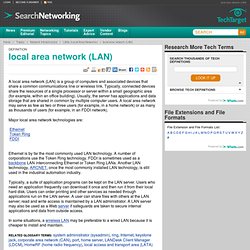

Network Computing. Wireless Networks and WiFi Technology. Most agree that wireless networking represent the future of computer and Internet connectivity worldwide.

Wi-Fi continues to be the pre-eminent technology for building general-purpose wireless networks. What is Wireless Networking? In computer networking, wireless technology is a modern alternative to networks that use cables. A wireless network transmits data by microwave and other radio signals. Benefits of (Wireless) NetworkingAny kind of network technology (either wired or wireless) increases the usefulness of home and business computers.
Introduction to Making Wireless Network ConnectionsLearn how to make the three basic kinds of wireless connections, via peer-to-peer, router, and hotspot networking. Introduction to Wi-Fi Wireless NetworkingThe term 'Wi-Fi' refers to a set of data link and physical layer technology standards for wireless networking that have become extremely popular for home networking and other kinds of local area networks. Wireless network. Wireless icon.

A wireless network is any type of computer network that uses wireless data connections for connecting network nodes. Wireless networking is a method by which homes, telecommunications networks and enterprise (business) installations avoid the costly process of introducing cables into a building, or as a connection between various equipment locations.[1] Wireless telecommunications networks are generally implemented and administered using radio communication. This implementation takes place at the physical level (layer) of the OSI model network structure.[2] Examples of wireless networks include cell phone networks, Wi-Fi local networks and terrestrial microwave networks.
Wireless links[edit] Computers are very often connected to networks using wireless links Terrestrial microwave – Terrestrial microwave communication uses Earth-based transmitters and receivers resembling satellite dishes. Types of wireless networks[edit] Wireless PAN[edit] A local area network (LAN) is a group of computers and associated devices that share a common communications line or wireless link.

Typically, connected devices share the resources of a single processor or server within a small geographic area (for example, within an office building). Usually, the server has applications and data storage that are shared in common by multiple computer users. A local area network may serve as few as two or three users (for example, in a home network) or as many as thousands of users (for example, in an FDDI network). LAN - Local Area Network (LAN)
Definition: A local area network (LAN) supplies networking capability to a group of computers in close proximity to each other such as in an office building, a school, or a home.

A LAN is useful for sharing resources like files, printers, games or other applications. A LAN in turn often connects to other LANs, and to the Internet or other WAN. Most local area networks are built with relatively inexpensive hardware such as Ethernet cables, network adapters, and hubs. Wireless LAN and other more advanced LAN hardware options also exist. Specialized operating system software may be used to configure a local area network. The term LAN party refers to a multiplayer gaming event where participants bring their own computers and build a temporary LAN. Also Known As: local area network Examples: The most common type of local area network is an Ethernet LAN. Local area network. A local area network (LAN) is a computer network that interconnects computers within a limited area such as a home, school, computer laboratory, or office building using network media.[1] The defining characteristics of LANs, in contrast to wide area networks (WANs), include their smaller geographic area, and non-inclusion of leased telecommunication lines.

[citation needed] ARCNET, Token Ring and other technology standards have been used in the past, but Ethernet over twisted pair cabling, and Wi-Fi are the two most common technologies currently used to build LANs. History[edit] A conceptual diagram of a local area network using 10BASE5 Ethernet The increasing demand and use of computers in universities and research labs in the late 1960s generated the need to provide high-speed interconnections between computer systems. Cambridge Ring was developed at Cambridge University in 1974[4] but was never developed into a successful commercial product. Standards evolution[edit] Cabling[edit]